Possessive PronounsWhat is your favorite type of cuisine? What is the favorite snack of your best buddy? Is your favorite the same as theirs? Is yours distinct from theirs? While these queries are likely to have made you hungry, they also demonstrate how we employ pronouns in statements. 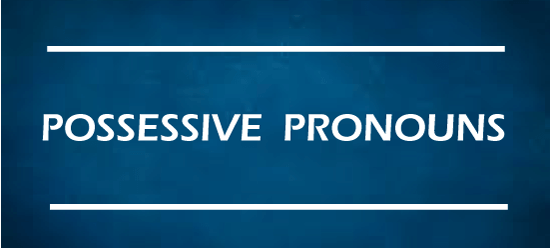
Pronouns are a significant aspect of speech that substitute nouns and can perform all of the same functions as nouns. Our delectable questions included instances of a kind of pronoun termed as a possessive pronoun. What Are Possessive Pronouns?A possessive pronoun is one that expresses ownership or possession. In the line, Charlie noted that Jeff's puppy was taller than hers; for example, the term hers is a possessive pronoun. The word hers denotes that "Charlie's puppy" (the noun phrase substituted by the term hers) is Charlie's. 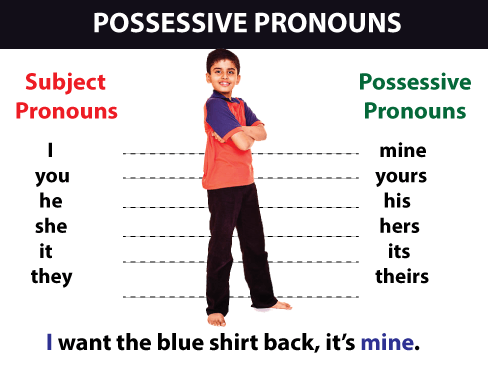
Possessive pronouns, like possessive adjectives, have additional functions. They can, for instance, be used to signify origin or a specific relationship: Origin: Portland is William's home, and Africa is ours. ('Ours' substitutes 'our house.') This statement indicates that we are from Africa.) Relationship: I brought my baby brother to the celebration, and Bella brought hers too. ("Her" substitutes "her sister.") Possessive pronouns do precisely what they appear to do. They, like all pronouns, substitute nouns in sentences. Possessive pronouns help us express the possession or ownership of a noun. They are not, even so, the same as possessive adjectives. Mine, yours, his, hers, its, ours, yours, and theirs are possessive pronouns (also known as "absolute" or "strong" possessive pronouns). They take the place of a previously utilized noun or a noun phrase in order to prevent repetition: "I said that glass was mine." My, your, his, her, its, our, your, and their are possessive adjectives (also known as "weak" possessive pronouns). They serve as a determiner before a noun, describing who something belongs to. "I said that's my glass," for instance. In a broad sense, possessive pronouns are used to refer to a previously explained individual, location, or object. They keep a sentence from repeating itself. List of Possessive PronounAttempt using a few of these possessive pronouns in your own phrases nowadays that you understand how they work. Here's a refresher on possessive forms: The subject pronoun includes - I, you, he, she, it, we, they Possessive (absolute) includes - Mine, yours, his, hers, its, ours, theirs Possessive (adjective) includes - my, your, his, her, its, our, their Some possessive pronoun and possessive adjective, such as his and its, are interchangeable. However, in most instances, the term you choose is determined by how you intend to use it. Possessive Pronoun ExamplesWhen presenting the same notion, possessive pronouns allow us to be more precise and use fewer or less words. Examine the following examples to see if you can comprehend one statement better than the other:
The best approach to become acquainted with possessive pronouns is to practice using them. Consider the following examples: Check out these instances of possessive adjectives in italicized and absolute possessive pronouns in bold.
Remember that possessive pronouns do more than just replace nouns; they demonstrate ownership of an individual, a location, or an item. They can, though, exist alone, unlike possessive adjectives. Now let us see a few examples of Singular and Plural Possessive pronouns. SingularLess Clear - That is his garage, and this one here is my garage. More Clear - That is her truck, and this is mine. Less Clear - Let us see if Deepti's hand is longer than your hand More Clear - Let us see if Deepti's hand is longer than yours. Less Clear-Veronica said we could rest at her apartment, but I'm not sure which one is her apartment. More Clear-Veronica said we could rest in her apartment, but I'm unsure which one is hers. PluralLess Clear- Enna's celebration was fantastic but sit tight until she visits to our celebration. More Clear- Emilia's celebration was fantastic but sit tight until she visits to ours. Less Clear- This is my cookies stack, but that one is for every one of you. More Clear-This is my cookies stack, and that is yours. Less Clear-We do not believe our group will be able to beat their group. More Clear-We don't believe our group can beat theirs. 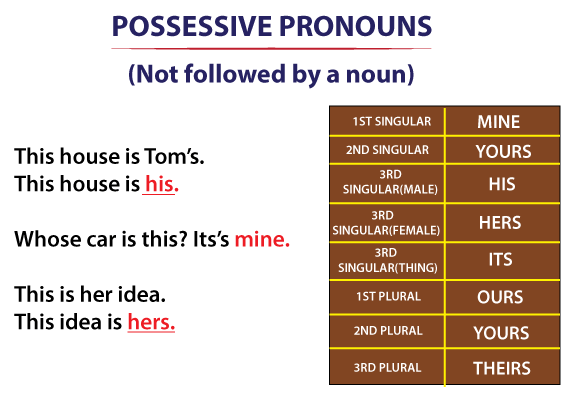
Possessive pronouns: How to Use ThemBefore we move further into possessive pronouns, it's good to study how pronouns are employed in statements in general. Pronouns, in brief, take the role of noun and noun phrases. This indicates that pronouns obey the same grammatical rules as a noun and can be utilized anywhere a noun can (i.e., subjects or objects). Proper application Possessive pronouns can be utilized to allude to both subjects and objects: Subject: Tom has already received his gift. Mine hasn't arrived yet. Object: Divya found my suitcase, but we've not located hers yet. When used in phrases, a possessive pronoun corresponds to the owner's number rather than the owned or the possessed item (s). As an example, I saw Pooja holding the notebook. (The owner's name is Pooja.) I believe this is her notebook. I saw Pooja holding the notebooks. These books appear to be hers. (The owner's name remains Pooja.) When a possessive pronoun is employed as a subject, difficulties occur. When employed as the subject, the verbs turn out to be singular or plural depending on the number of persons or items mentioned rather than on the owner. As an example, Joseph's favorite film is a comedy film. My movie is a scary movie. (One film.) Mozzarella and chicken are Jane's favorite pizza ingredients. (A variety of pizza ingredients.) My favorites are meat and strawberries. It is critical to specify which possessive pronoun is substituting noun or noun phrase like all other pronouns. Much of the time, even if it isn't clearly mentioned, a person can utilize context to understand who or what is being addressed to: Unclear: We discovered ours. (What is ours?) We discovered Steve's kitty, and he found ours. (Although the sentence does not explicitly state it, we can infer from context that ours pertains to "our kitty.") 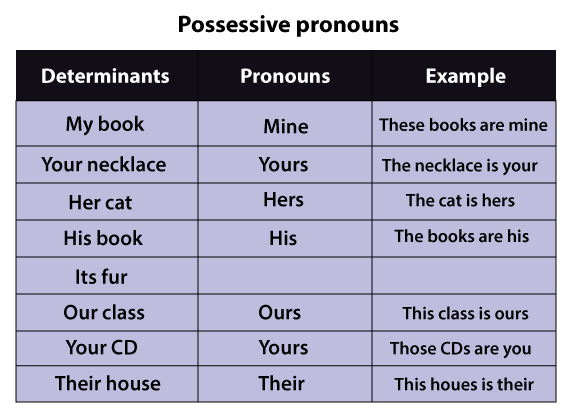
His as A Possessive PronounThe term his can be characterized as a possessive pronoun or a possessive adjective based on the way it is employed in the statement. It is regarded as a pronoun if it is employed as a subject or an object. It is regarded as an adjective when it is used to alter a noun. Possessive pronoun: I put my slippers on, and David put his on. (His is being utilized as an object.) In this statement, his is a pronoun.) Possessive adjective: I believe this is his helmet. (His modifies the word helmet.) In this line, his is an adjective.) Adverbs are used to explain the conditions around an event or to intensify it. Can you list six different sorts of adverbs? Find out how to utilize them here. It's as a Possessive Pronoun.Finally, we must consider the pronoun its. This word can be employed in the similar way as the other possessive pronouns. For instance, The dog knew instantly which disc was its. ("Its" takes the place of "the dog's disc.") The plant's petals were distinct from the rest. It were crafted from gold. (It takes the place of "the plant's petals.") The preceding two statements will appear and sound strange to several English speakers. It is uncommon to use the term its as a possessive pronoun, and it is frequently ignored in daily writing and conversation. Rather, the term its is used much more frequently as a possessive adjective. Common Error - Its vs. It'sThe use of an apostrophe in the possessive adjective is a common error. It's easy to mix up its with its abbreviation, it's, which does feature an apostrophe. But keep in mind that possessive adjectives never employ apostrophes. Incorrect- The ship lost it's sail in the rain. Correct -The ship lost its sail in the rain. Incorrect-You should not judge a book by it's outer look. Correct- You should not judge a book by its outer look. 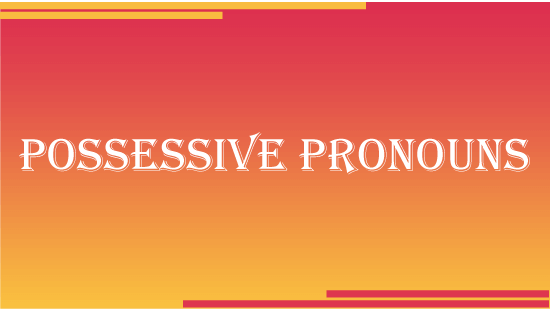
Improper Usage of Possessive PronounsTo begin, possessive pronouns can only be utilized when a noun or another pronoun can also be employed (as a subject or an object). Possessive pronouns are NOT modifiers, which implies they should not be put in lieu of adjectives, adverbs, or other comparable parts of speech. As stated previously, the term his is the exception to the rule. Correct: I've had my meal, and you've had yours. (Yours is correctly utilized as the subject of a statement.) Incorrect: This is my meal, and that is your meal. (Yours is mistakenly employed as an adjective. Rather, the possessive adjective you should be used in this statement.) Second, possessive pronouns must be consistent with the nouns or noun phrases they substitute. A singular noun employs a singular pronoun, while a multiple nouns employs a plural pronoun. Correct: Nick couldn't recall which chair belonged to him. (The term his refers to a chair owned by Nick.) Nick is a singular noun. Hence the singular pronoun his is required.) Incorrect: I glanced for my chair, but I couldn't recollect which chair was ours. (According to the text, I am looking for a chair that is mine.) Because the term me is singular, the singular pronoun my is used rather than the plural pronoun ours.) Remember that the possessive pronoun yours can be singular or plural, based on how many individuals you are addressing to. Correct: Leela, I got you! Here, this blazer is yours. (Leela and yours are both singular.) Correct: Hello, my buddies! I'll show you which bedroom is yours if you accompany me. (Buddies and yours are both plural.) Whereas the word theirs is most commonly employed as a plural possessive pronoun, it can also be employed as a singular possessive pronoun. For instance, we can use the singular theirs to imply to people without identifying their gender: The kid knew exactly which handbag was theirs. Each kid must take their report cards to the teacher.
Next TopicPronoun Examples
|
 For Videos Join Our Youtube Channel: Join Now
For Videos Join Our Youtube Channel: Join Now
Feedback
- Send your Feedback to [email protected]
Help Others, Please Share










